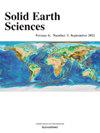Application of machine learning in python for temporal groundwater level prediction
IF 2
4区 地球科学
Q3 GEOSCIENCES, MULTIDISCIPLINARY
引用次数: 0
Abstract
Groundwater is a critical resource for sustaining agricultural, domestic, and ecological needs in the Upper Blue Nile Basin of Ethiopia, where rapid population growth and climate variability have intensified water stress. The Temecha River Catchment, part of this basin, faces recurrent droughts and declining groundwater levels, underscoring the need for effective groundwater management strategies. One promising approach is Managed Aquifer Recharge (MAR), whose success relies heavily on accurate groundwater level monitoring and forecasting. Although MAR decisions are influenced by hydrogeological and land use factors, hydraulic head data are essential for determining recharge timing and suitability. This study evaluates the performance of five machine learning models—Gradient Boosting Regression (GBR), Support Vector Machine (SVM), Random Forest (RF), Decision Tree (DT), and Linear Regression (LR)—for predicting groundwater level fluctuations in the Temecha River Catchment from 1995 to 2023. Rainfall, temperature, and evapotranspiration were used as predictive variables. Among the models, GBR showed superior performance, with a Mean Absolute Error (MAE) of 0.07 m, Nash-Sutcliffe efficiency (NSE) of 0.7934 m, Coefficient of Determination (R2) of 0.7856, and Percent Bias (PBIAS) of −2.408 %. The results demonstrate GBR's effectiveness in groundwater level forecasting and support its application in data-scarce regions to inform sustainable water resource management. However, adaptation to other regions must consider local hydrogeological and climatic conditions.
One sentence summary: This study explores the use of machine learning techniques in Python to predict temporal groundwater levels in the Temecha River Catchment.
python语言中机器学习在地下水位预测中的应用
在埃塞俄比亚的上青尼罗河流域,地下水是维持农业、家庭和生态需求的关键资源,该地区人口的快速增长和气候变化加剧了水资源压力。作为该盆地一部分的Temecha河集水区面临着经常性干旱和地下水水位下降的问题,这凸显了制定有效地下水管理战略的必要性。一种很有前景的方法是管理含水层补给(MAR),其成功在很大程度上依赖于准确的地下水位监测和预测。尽管MAR决策受到水文地质和土地利用因素的影响,但水头数据对于确定补给时间和适宜性至关重要。本研究评估了梯度增强回归(GBR)、支持向量机(SVM)、随机森林(RF)、决策树(DT)和线性回归(LR)五种机器学习模型的性能,用于预测1995年至2023年特梅恰河流域地下水水位波动。降雨、温度和蒸散量被用作预测变量。其中,GBR模型的平均绝对误差(MAE)为0.07 m, Nash-Sutcliffe效率(NSE)为0.7934 m,决定系数(R2)为0.7856,百分比偏差(PBIAS)为- 2.408%,表现出较好的性能。结果证明了GBR在地下水位预测中的有效性,并支持其在数据稀缺地区的应用,为可持续水资源管理提供信息。然而,适应其他地区必须考虑当地的水文地质和气候条件。一句话总结:这项研究探索了在Python中使用机器学习技术来预测Temecha河集水区的地下水水位。
本文章由计算机程序翻译,如有差异,请以英文原文为准。
求助全文
约1分钟内获得全文
求助全文
来源期刊

Solid Earth Sciences
GEOSCIENCES, MULTIDISCIPLINARY-
CiteScore
3.60
自引率
5.00%
发文量
20
审稿时长
103 days
 求助内容:
求助内容: 应助结果提醒方式:
应助结果提醒方式:


